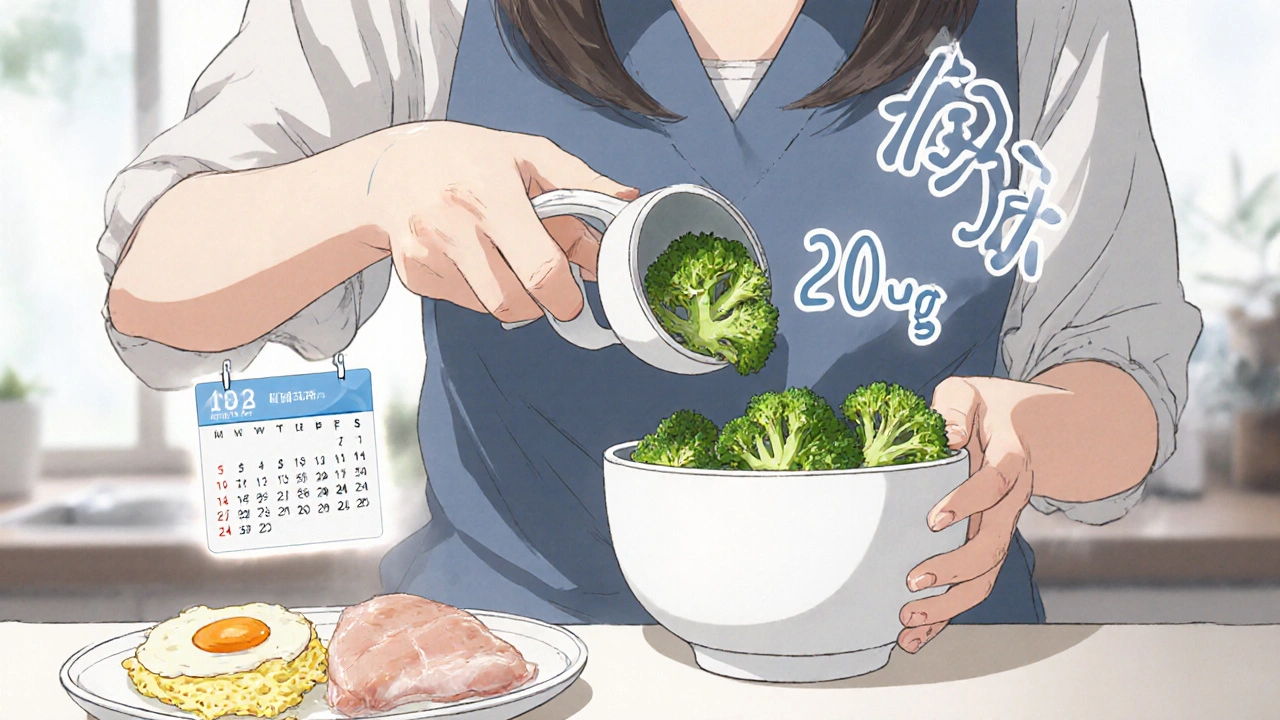Vitamin K Intake Calculator for Warfarin Patients
Calculate Your Daily Vitamin K Intake
Enter your meals to see if your vitamin K intake falls within the recommended range of 60-120 micrograms per day. Consistent intake helps stabilize your INR.
Add Your Food Items
Your Current Intake
Why This Matters
Your INR (International Normalized Ratio) should stay between 2.0-3.0 for most people on warfarin. Consistent vitamin K intake helps maintain stability. Eating too much vitamin K can lower your INR (increasing clot risk), while eating too little can raise your INR (increasing bleeding risk).
Recommended intake: 60-120 micrograms per day for stable INR levels.
Outside target range: Intake less than 60 µg or more than 120 µg may lead to unstable INR levels.
When you’re on warfarin, your life doesn’t revolve around avoiding green vegetables - it revolves around consistency. For years, patients were told to cut out spinach, kale, and broccoli because they’re high in vitamin K. That advice was wrong. Today, doctors know the real problem isn’t eating vitamin K - it’s eating too much one day and too little the next. This inconsistency causes your INR to swing wildly, raising your risk of clots or dangerous bleeding.
Why Vitamin K Matters When You’re on Warfarin
Warfarin works by blocking your body’s ability to recycle vitamin K, which is needed to activate clotting factors. Without enough active vitamin K, your blood takes longer to clot - that’s the goal. But if you suddenly eat a big bowl of cooked spinach (which has nearly 900 micrograms of vitamin K), your body gets a flood of the very thing warfarin is trying to suppress. Your INR drops. If you skip greens for three days, your vitamin K levels fall, and your INR spikes. Neither is safe.The International Normalized Ratio (INR) is the number your doctor watches. For most people on warfarin - like those with atrial fibrillation or a history of blood clots - the target range is 2.0 to 3.0. If you have a mechanical heart valve, it might be 2.5 to 3.5. Staying in that range means you’re protected from clots without bleeding too easily.
Research shows patients who eat inconsistent amounts of vitamin K have more than twice the number of INR readings outside the safe range compared to those who eat about the same amount every week. A 2019 study in Thrombosis and Haemostasis found that even small daily changes in vitamin K intake caused major INR swings. The fix? Don’t avoid vitamin K. Just keep it steady.
The Recommended Daily Amount Isn’t What You Think
The official Recommended Dietary Allowance (RDA) for vitamin K is 90 micrograms for women and 120 for men. But most people in the U.S. already eat close to that - about 93 micrograms for women and 122 for men, according to national health surveys. That means you’re probably not deficient. You just need to avoid big spikes.Here’s what counts as a typical daily dose of vitamin K:
- 1 cup cooked spinach: 889 µg
- 1 cup raw kale: 547 µg
- ½ cup cooked broccoli: 102 µg
- 1 scrambled egg: 20 µg
- 3 oz chicken breast: 2 µg
Notice something? A single serving of spinach has nearly 10 times the RDA. That’s why eating it once a week is fine - if you don’t eat it the other six days. But if you eat spinach Monday and then kale Wednesday and then no greens the rest of the week? Your INR will bounce like a rubber ball.
Experts now recommend keeping your daily vitamin K intake between 60 and 120 micrograms - not to cut back, but to stay predictable. That’s about one serving of leafy greens every other day, spread evenly across the week.
Why Restricting Vitamin K Makes Things Worse
For decades, patients were told to avoid vitamin K-rich foods entirely. That advice is outdated - and dangerous. A 2020 guideline from the American College of Chest Physicians explicitly says: “Dietary vitamin K restriction is not recommended and may be harmful.”Why? Because when you avoid vitamin K, your body starts to run low. That causes your clotting factors to become undercarboxylated - meaning they don’t work properly. Studies show patients on low-vitamin-K diets have 37% more day-to-day INR variation than those who eat consistent amounts. That’s not stability - that’s chaos.
One landmark study in Blood gave unstable warfarin patients 150 micrograms of vitamin K daily. The result? Their time in the target INR range jumped from 58.4% to 65.6%. No more bleeding. No more clots. Just better control.
Another study from the University of Iowa found that patients who kept their vitamin K intake within 20% of their normal daily amount increased their time in therapeutic range by nearly 15 percentage points. That’s the difference between having a good month and having a dangerous one.

Real People, Real Results
Online forums and patient surveys reveal how common mistakes are - and how simple fixes work.On Reddit, one user wrote: “My INR was all over the place until my pharmacist gave me a vitamin K tracking sheet - now I eat exactly 1 cup of mixed greens every Tuesday and Thursday and my TTR jumped from 45% to 78%.”
That’s not luck. That’s structure. You don’t need to eat the same exact meal every day. You just need to eat about the same amount of vitamin K, on about the same schedule.
But here’s the problem: 68% of patients say they were confused at first. And 42% cut out all green vegetables, thinking they were doing the right thing. That’s why 31% of warfarin users end up in the emergency room in their first year - and in 57% of those cases, inconsistent diet was the main reason.
Patients who get personalized counseling from anticoagulation pharmacists do far better. One study showed they hit an 82% time in therapeutic range - compared to just 63% for those who got standard advice. That’s not a small difference. That’s life-changing.
How to Get It Right: Simple Steps
You don’t need to become a nutritionist. You just need a system.- Track for 4-6 weeks. Use a food diary or an app like Warframate (available on iOS and Android). Log everything you eat, especially leafy greens. You’ll see patterns you never noticed.
- Measure your portions. Don’t guess. A “handful” of spinach can be 200 micrograms or 800 - it depends on how tightly you pack it. Use measuring cups. A half-cup cooked broccoli is 102 µg. A full cup of raw kale is 547 µg. Write those numbers down.
- Pick your vitamin K days. Decide how many days a week you’ll eat vitamin K-rich foods. Two? Three? Stick to it. If you eat spinach on Tuesday, don’t eat kale on Thursday. Stick to the same food group. If you eat greens, keep it the same type and amount.
- Don’t make sudden changes. If you want to add a new vegetable, wait until your next INR check. Talk to your pharmacist first. Don’t just start eating more kale because you heard it’s “healthy.”
- Be consistent with supplements. If you take a multivitamin, check the label. Some have vitamin K. If you start or stop one, tell your doctor. Same with herbal supplements like ginkgo, garlic, or green tea extract - they can interfere too.
One simple meal plan that works for many people:
- Breakfast: 1 scrambled egg (20 µg)
- Lunch: ½ cup cooked broccoli (102 µg)
- Dinner: 3 oz chicken breast (2 µg)
- Total: 124 µg - right in the target range.
That’s it. No spinach. No kale. Just predictable, balanced meals.

Genetics Play a Role - But Not the One You Think
Some people are naturally more sensitive to vitamin K because of their genes. Variants in the VKORC1 or CYP2C9 genes can make you respond more strongly to small changes in diet. About 15-30% of INR variability still can’t be explained - and diet is the biggest piece of that puzzle.Research is starting to use genetic testing to personalize vitamin K targets. For example, people with certain gene variants may need to keep their intake within 10% of their normal amount. Others can handle up to 25% variation. But you don’t need a DNA test to start. Just track your diet and INR for a few weeks. You’ll see how your body reacts.
What to Do If Your INR Is Off
If your INR is too high (above 4.0), you’re at risk of bleeding. If it’s too low (below 1.5), you’re at risk of clots. But don’t panic. Don’t skip your next dose. Don’t eat a giant salad to “fix” it.Call your anticoagulation clinic or pharmacist. They’ll look at your diet log, your medications, and your recent INR trends. They might adjust your warfarin dose - or just remind you to stick to your usual greens routine.
Most INR swings aren’t caused by a single meal. They’re caused by weeks of inconsistency. Fix the pattern, not the number.
Final Thought: It’s About Routine, Not Restriction
You don’t have to give up your favorite foods. You don’t have to eat bland meals. You just have to be predictable. Eat your greens. Just eat them the same way, the same amount, most days. That’s how you take control of your warfarin therapy - without feeling like you’re on a diet.One patient summed it up perfectly: “I thought I had to choose between my health and my food. Turns out, I just had to choose consistency.”
Can I eat spinach while on warfarin?
Yes - but only if you eat it consistently. Eating spinach every day is fine. Eating it one day and skipping it for a week is not. The goal is to keep your daily vitamin K intake steady, not zero.
Should I avoid all green vegetables?
No. Avoiding green vegetables can actually make your INR less stable. Studies show patients who restrict vitamin K have more fluctuations and higher risk of bleeding. Eat them - just keep your portions regular.
How much vitamin K is too much?
There’s no fixed limit. What matters is consistency. Eating 900 µg of spinach once a week is less risky than eating 100 µg one day and 500 µg the next. Aim for 60-120 µg per day on average, and keep your daily intake within 20% of your normal amount.
Can I take a vitamin K supplement?
Only under medical supervision. Some patients benefit from a daily 150 µg supplement to stabilize INR, but it must be consistent. Never start or stop a supplement without talking to your pharmacist or doctor.
Why does my INR change even when I eat the same food?
Other factors can affect INR: new medications, illness, alcohol, changes in liver function, or even travel. But diet is still the most common cause of unexplained swings. If your diet hasn’t changed and your INR is off, talk to your provider - it could be something else.
Do I need to use an app to track vitamin K?
Not necessarily, but it helps. Apps like Warframate have databases of over 1,200 foods with vitamin K values. If you don’t use an app, just keep a simple written log. The key is tracking - not perfection.
How long does it take to see results from consistent eating?
Most people see improvements in their INR stability within 2-4 weeks. After 6 weeks, many report fewer INR checks, fewer dose changes, and less anxiety. Consistency doesn’t fix everything overnight - but it fixes the biggest cause of instability.

Rusty Thomas
November 20, 2025 AT 21:25OMG I JUST REALIZED I’VE BEEN DOING THIS ALL WRONG 😭 I ate a giant kale salad on Tuesday, then nothing for 4 days, and my INR went to 5.2. My pharmacist looked at me like I’d just set my cat on fire. Now I eat 1/2 cup cooked broccoli every Monday and Thursday like a robot. My TTR is 81%. 🙌
Sarah Swiatek
November 21, 2025 AT 06:19It’s wild how medicine keeps changing its mind, isn’t it? For decades we were told to avoid vitamin K like it was poison. Now we’re told to eat it-but only if you’re boring about it. The real villain here isn’t spinach, it’s inconsistency. Our bodies crave rhythm, not extremes. Think of it like sleep: one night of 8 hours and three nights of 4? You’ll feel like trash. Same with vitamin K. Your liver doesn’t care about your ‘healthy eating phase’-it just wants predictability. And honestly? That’s kind of beautiful. We don’t need superfoods. We need routines.
Dave Wooldridge
November 22, 2025 AT 16:25THIS IS A PHARMA TRICK. THEY WANT YOU TO EAT GREENS SO YOU’LL NEED MORE WARFARIN. THEY’RE MAKING MONEY OFF YOUR CONFUSION. WHY DID THEY TELL YOU TO AVOID IT BEFORE? BECAUSE THEY KNEW YOU’D BE TOO STUPID TO STICK TO A PLAN. NOW THEY’RE SELLING YOU ‘APP TRACKERS’ AND ‘PERSONALIZED COUNSELING’-ALL TO KEEP YOU DEPENDENT. I STOPPED WARFARIN AND NOW I JUST TAKE GARLIC AND CAYENNE. MY BLOOD IS THIN AND I’M FREE. 🕊️
Rebecca Cosenza
November 22, 2025 AT 21:52Consistency > obsession. 🌿
Cinkoon Marketing
November 24, 2025 AT 21:35Actually, in Canada we’ve been doing this for years-pharmacists hand out printed charts with portion sizes. No app needed. Just write it down. Also, if you’re eating kale every day, you’re probably not getting enough protein. Balance, people. 🇨🇦
swatantra kumar
November 26, 2025 AT 01:58Bro, I’m from India and we eat spinach every day in saag paneer. My INR? Stable as hell. I don’t track shit. I just eat the same thing every day. 🍛 The real issue? Americans think ‘healthy’ means ‘new food every day.’ In my village, we eat the same dal and greens for 40 years. No apps. No panic. Just life. 🙏
robert cardy solano
November 27, 2025 AT 17:12My wife’s been on warfarin for 8 years. She eats the same exact breakfast every day-2 eggs, 1/2 cup broccoli, and a cup of green tea. No drama. No apps. Just routine. She’s had maybe 2 INR spikes in 8 years. Everyone else is overcomplicating it. Sometimes the answer isn’t more data-it’s less noise.
Pawan Jamwal
November 28, 2025 AT 13:12How can Americans be so clueless? In India, we’ve known for centuries that greens = blood health. You don’t need a fancy app. You need discipline. And respect for tradition. This post is just proof that Western medicine overthinks everything. 🇮🇳
Bill Camp
November 30, 2025 AT 02:14They’re lying. You know who profits from you eating greens? Big Ag. The same corporations that sell you glyphosate-laced kale. They want you dependent on drugs AND their food. Don’t be fooled. Eat organic. Or don’t eat at all. But don’t let them tell you what ‘consistent’ means.
Lemmy Coco
December 1, 2025 AT 14:44hey so i just started warfarin last month and i was so scared of greens i was eating only white rice and chicken. then i found out my doc said consistency is key so i started eating 1/2 cup broccoli every tuesday and thursday and my inr is finally in range! i still forget to log it sometimes but im getting better 😅
rob lafata
December 2, 2025 AT 02:02You’re all missing the real point. This isn’t about vitamin K. It’s about control. The system wants you to track, log, and obsess-so you never question why you’re on warfarin in the first place. Why not reverse the condition? Why not fix your liver? Your gut? Your stress? No. You get a checklist. You get an app. You get told to eat spinach like a monk. This isn’t medicine. It’s behavioral conditioning. And you’re all just happy little bots clicking ‘save’ in Warframate like it’s some kind of spiritual practice. Wake up.
Matthew McCraney
December 2, 2025 AT 08:50I used to eat spinach every day. Then I got a blood clot. Now I don’t trust ANYTHING. I only eat canned tuna and white bread. I don’t care what the ‘studies’ say. My body’s been betrayed once. I’m not letting it happen again. And yeah, my INR’s all over the place. So what? At least I’m alive. And I didn’t fall for the ‘eat your greens’ cult.